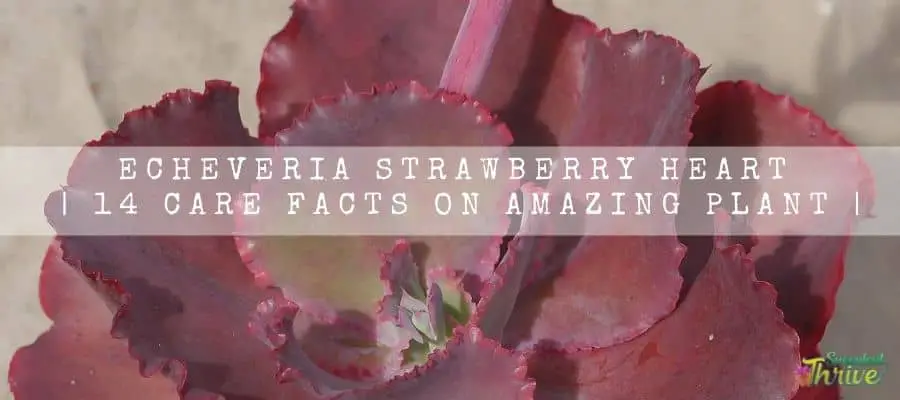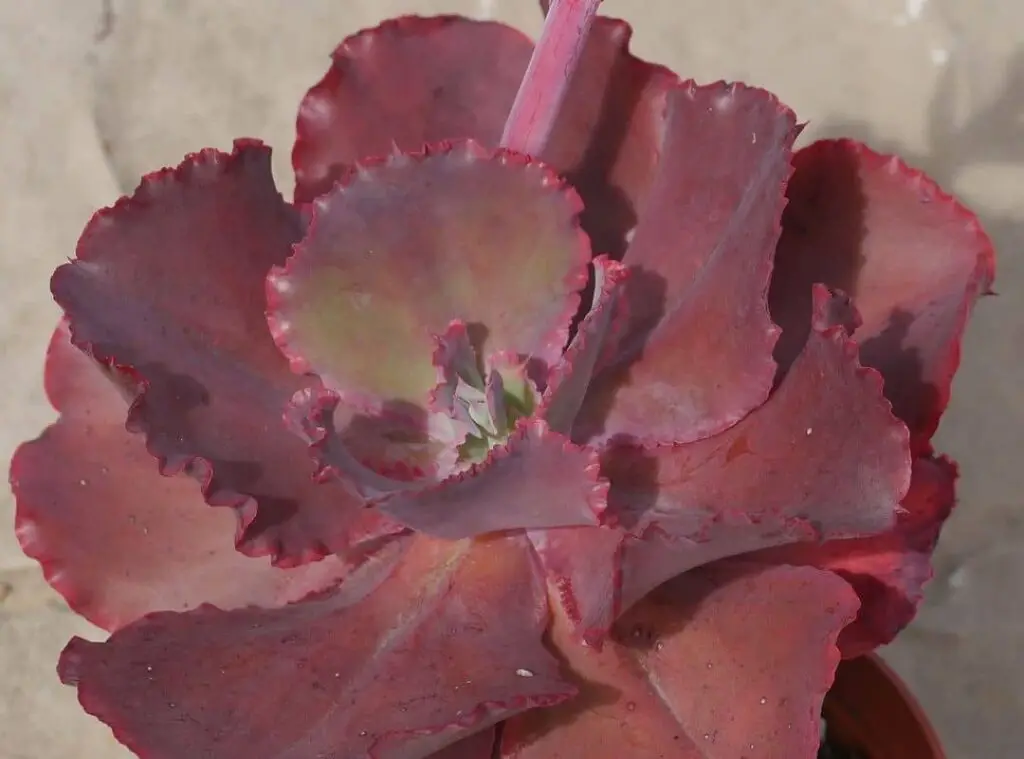Echeveria strawberry heart succulent is a unique member of the Echeveria family.
It is an easy to care plant which could thrive in different lighting conditions. The plant will exhibit its unusual foliage in full sunlight outdoors or milder climates.
I decided to share some facts about the Echeveria strawberry heart in this article with you.

How do I identify Echeveria Strawberry Heart?
You could identify the Echeveria strawberry heart by its unusual foliage color.
This plant is a work of art by Dick Wright. He introduced this hybrid in 1965 from his nursery. Apart from strawberry heart, Mr Wright had introduced various Echeveria hybrids to the world since 1958.
They are evergreen plants, and you could mainly spot the Echeveria strawberry in burgundy or in maroon. Their leaves form in rosette shape.
One look care guide
| Botanical Name | Echeveria ‘strawberry heart’ |
| Common Name | Echeveria ‘strawberry heart’ |
| Plant Type | Succulent |
| Sun Exposure | Full Sunlight to Partial sunlight |
| Soil Type | Well-draining |
| Soil pH | 6.0 |
| Hardiness Zones | USDA zones 9b-11. (25 degrees Fahrenheit – 40 degrees Fahrenheit). |
| Toxicity | Nontoxic |
How do you take care of Echeveria Strawberry Heart?
Light Requirement
In terms of the light requirements of the Echeveria strawberry heart plants, it is important that you let them gain full sunlight to partial sunlight like many other succulents do in general.
As such when you grow them outdoors you should grow them in a place where they expose for at least 6 hours of bright sunlight and partial shade for the rest of the day.
If you spot any elongated shape of your plant, it will be a sign they indicate to show you that they run short of sunlight.
As such, the best is to shift them outdoors during summer. Having said that, you should be vigilant to not expose them to intense heat waves since that could lead to sunburns in the plant.
However, If you plan to keep them indoors, keep the plant 1 feet away from the window to avoid intense sunlight.
Echeveria strawberry heart , when grown under bright light, exhibits a more compact and less relaxed leaf pattern.
Temperature and humidity
Echeveria strawberry heart plants would prefer to grow in dry air. As such best would be to expose them for low humidity levels.
Refrain in exposing them for temperatures above 100 degrees Fahrenheit and temperatures below 32 degrees Fahrenheit.
Is it cold hardy?
No, this plant is not cold hardy
USDA Hardiness Zone
Echeveria strawberry heart plants fall under USDA zones 9b-11. (25 degrees Fahrenheit – 40 degrees Fahrenheit).
Watering Requirement
Watering is the most important factor when taking care of these plants. Echeveria strawberries are not dependent on water just like the rest of other succulents.
Having said that, they would still love to have water during hot & dry weather conditions. If you spot your Echeveria strawberry plants leaves are dying and wrinkled, it is an indication of under watering.
If you are unsure how much water your plant wants, It is always better to under water then rather than over watering them.
Simply because you could always revue an under watered plant with a one or two drinks of water. While on the other hand, when you overwater a plant, it could lead to root rot.
In addition to that it would make the plant more vulnerable for mealybugs attacks. Chances are that root rot could be fatal on the plants.
When watering them, you should let the soil become dry from the previous watering and only then water them.
Once you complete watering them ensure that excess water is draining through the draining holes.
Further if you have located a saucer under the pot, you need to empty the excess water in the saucer.
Further you need to fasten watering during seasons like summer. On the other hand, you need to water them less during winter. You should water them during winter only to avoid wrinkled leaves.

Soil Requirement Type / pH
When it comes to the right soil mix, it is important that you grow them in a well-draining soil mix.
6 parts of pumice or perlite + 2 parts of compost + 2 parts of coarse sand would be an ideal soil mix to grow these plants.
Alternatively, you may use a readily available succulent soil mix or a cactus soil mix.
The ideal ph. of the soil mix should be 5.6-7.8. (Moderately acidic – slightly alkaline).
Pot size Potting and Repotting
You do not have to repot Echeveria strawberry heart frequently. Instead you could consider repotting your echeveria strawberry when it is outgrown from its pot.
To repot you simply have to take it off and get rid of the older soil.
After that you may transplant them in a fresh soil mix. further I would recommend you report them in spring as it is the start of their growth season.
When it comes to selecting the pots, best is to grow them in an unglazed pot . If not you may use a terracotta pot which has enough draining holes as well.
When the pot has enough draining holes that will help the excess water to drain through the draining holes of the pot.
Where to Plant
You may grow Echeveria strawberry heart as annual plants.
However, you need to plant them in a bright sunny place ideally where they get exposed to bright sunlight in the morning and partial shade in the afternoon.
Fertilizer and time of year
Echeveria strawberry heart plants do not expect you to fertilize them regularly. They are used to grow in nutrient poor soil.
Best is to feed them occasionally during spring and summer.
You may use a cactus, succulent fertilizer or even a liquid fertilizer to feed them. You may skip feeding them during their dormancy.
Dormancy
Echeveria strawberry heart would go dormant during winter. During winter you do not have to feed them.
They will usually grow at a very slow rate during dormancy, and you could hardly spot a growth when they go dormant.
You should overwater them and overfeed them when they are dormant.
Other plants Pairs Well With
You may grow Echeveria strawberry with Agave and with Sempervivum as well.
Can be toxic to pets
Echeveria strawberry heart are not poisonous for pets and for humans as well. Having said that, you should not allow them to consume the parts of the plants though.
Common bugs and illnesses
Echeveria strawberries could encounter mealybug attacks in leaf axils. Further aphids could also attack them. In addition to that root rot will be a major concern.
If you come across such a situation, it could even have fatal repercussions on the plants.
To treat them, you should use an isopropyl alcohol spray or any other insecticide. Furthermore, you may consider repotting them as well.
Special Care tips
Ensure that you keep the plants under your observation to identify if there are any early signs of any disease.
How to propagate Echeveria Strawberry Heart
You may use offsets leaves or their stem cuttings to propagate these plants. When the Echeveria strawberries are matured enough they would produce offsets.
Then you simply have to remove them from the mother plant and propagate them as separate plants.
In addition to above, you may use their leaves to propagate these plants. You simply have to remove a leaf from the main plant stem by wiggling.
After that you may lay the leaf in the tray and locate the specimen in sunlight. However, do not expose them for direct sunlight.
When you are doing the leaf propagation method, you should always go ahead with more than one leaf as then it will be more successful. You could mist the soil lightly here.
When you spot the roots have formed you could start watering them as for regular plants. It will take about one months’ time to form the tiny rosette.
Rosset will be supplying the energy and the nutrients for the plants. As such do not separate the Rosset from the leaf.
As the time passes, the older leaf will perish, and the new pup will form into a nice healthy echeveria strawberry plant and thrive on its own.
Stem propagation is one more option you may try with these plants. This is not very common to practice with echeveria strawberry plants.
However, you could do this, particularly on the elongated echeveria plants. You could obtain the stem cutting during spring and allow those to become callous for some days.
After that you simply have to place them in a fresh soil medium. Start watering them like you do for the regular echeveria plants.
Echeveria Strawberry Heart plant benefits
They could be very handy to use for pots as well as for containers.
You may place them indoors or outdoors depending on our wish. They would look good in succulent arrangements as well.
Conclusion
As long as you take care of the Echeveria strawberry plants well, they will thrive well and vigorously.
They are easy to care for plants and you only need to make sure that you supply its necessities. In addition to that, their propagation is also very easy.
So why wait! start grabbing your echeveria strawberry plant and get that lovely experience of growing it.
Read Next : Echeveria Ebony | 15 Super Easy Care Facts For You |
